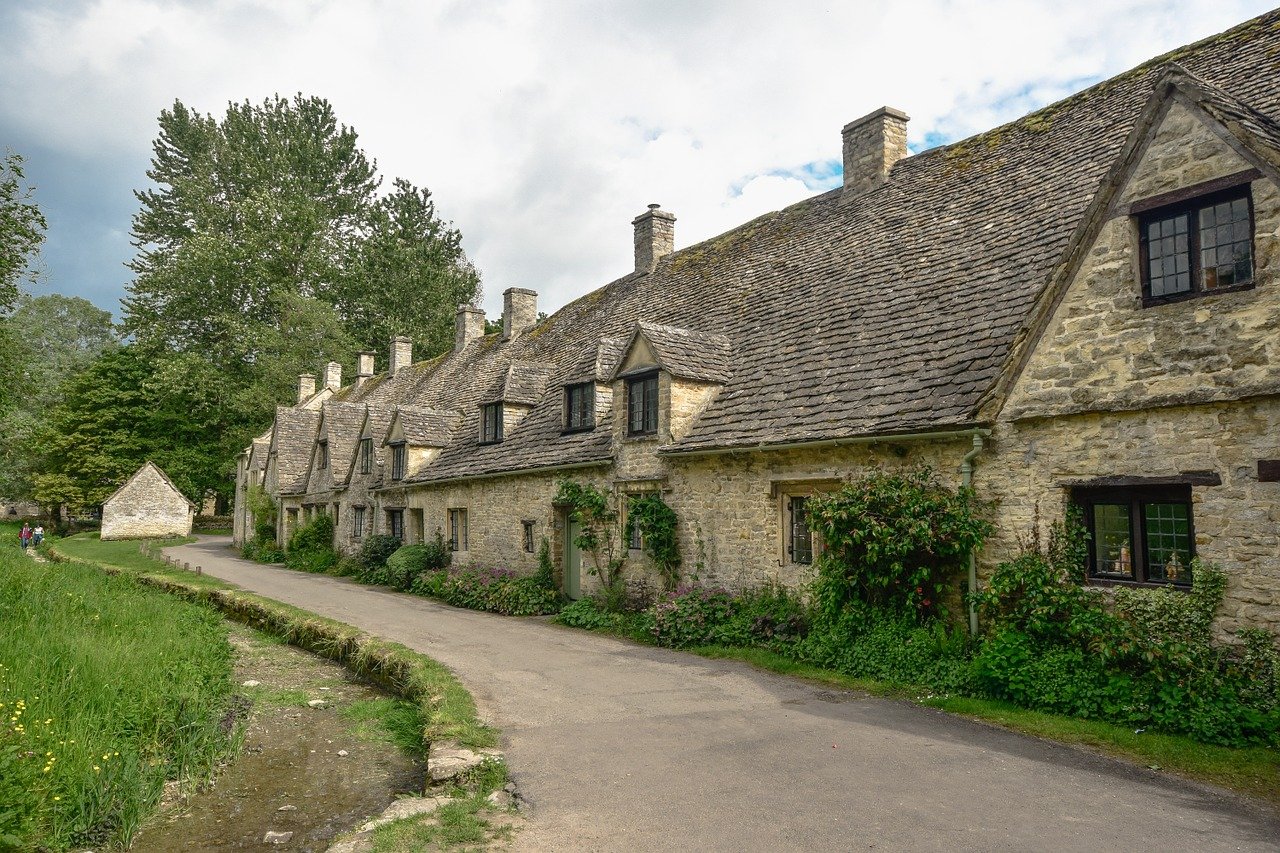As a holiday location, Gloucestershire doesn’t immediately spring to mind for most overseas visitors or short break seekers. Yet this attractive English county incorporates large swathes of the Cotswolds, the Royal Forest of Dean and the Severn Valley. What’s more, its picturesque landscape of water-meadows and rolling hills is graced by an assortment of historical villages and visitor attractions. With this in mind, here’s a guide to this picturesque region.
* Please bear in mind that many of the visitor attractions mentioned here are currently closed due to lockdown restrictions.
Towns and Villages
Bibury
Bibury nestles on the River Coln and is considered one of the most beautiful locations in all of England. Famous for its honey-coloured cottages, this quaint little village provides tantalising glimpses of bygone times. Significant historical visitor attractions include the seventeenth century Arlington Mill and the ancient Church of St Mary the Virgin, with its Saxon carvings and medieval stained glass windows.
Berkeley
The small, tranquil town of Berkeley lies on the east bank of the Severn and is of course most famous for its castle (see below). Also noteworthy however is its Grade I listed church, St Mary’s. Constructed in the eleventh century, St Mary’s houses a seven hundred year old font and a collection of tombs such as that of physician Edward Jenner who developed the world’s first vaccine.
Gloucester
The bustling cathedral city Gloucester evolved from the Roman fortified town of Glevum. For centuries, it guarded the routes to Wales which converged at the lowest crossing point of the River Severn. Today Gloucester remains an important commercial centre thanks largely to the canal which opened in 1827. Numerous historical buildings can be found on its streets like the medieval New Inn and sixteenth century Greyfriars ruin. But by far the most impressive is the imposing cathedral – framed within its towering 72ft east window is the second largest area of stained glass in the UK (after York Minster).
Painswick
This charming old wool town dates back to the fourteenth century. Within its confines is a collection of greystone buildings, constructed from locally quarried Cotswolds stone. The local parish church is Grade I listed – in its yard are 100 yew trees, some of which have been there since 1714.On the Sunday following September 19, the town holds a Clipping Ceremony – a medieval custom where children join hands and embrace the church while a hymn is sung. Painswick is set on the Cotswolds Way National Trail and serves as a great base for exploring this lovely part of the world.
Paradise
Paradise is a tiny hamlet just north of Painswick. It was named by Charles I during the siege of Gloucester during the English Civil War. The loyalist King considered it the most delightful spot he’d ever laid eyes on.
Tewkesbury
Set on the confluence of the River Severn and Avon, Tewkesbury was the site of a Yorkist victory in the War of the Roses. Although the town’s eclectic array of timbered black and white houses are a must-see, the centre-piece has to be its Abbey which features a magnificent 132 ft Norman tower. There are also numerous thirteenth and fourteenth century inns found throughout town such as the Royal Hop Pole Inn, mentioned in the Pickwick Papers, the timber-framed Bell Inn and the Black Bear. The sixteenth century Tudor House, now a hotel, has a priest’s hole set in its chimney.
Wotton-under-Edge
Wotton-under-Edge lies on the edges of the Cotswolds and is replete with numerous historical buildings including a 700 year-old church. Among its treasures are some fine engraved brasses and an eighteenth century organ build by Christopher Schrider for St Martin in the Fields. The organ was played by Handel when George I attended services there. As well as the church, Wotton-under-Edge is home to a collection of almshouses that date from 1632.
Major Visitor Attractions
Badminton House
This impressive Grade I Palladian mansion forms part of a 15,000 acre estate and has been the home of the Dukes of Beaufort for more than 200 years. Inside is a wonderful collection of Italian, Dutch and English paintings and some intricate carvings from famed sculptor Grinling Gibbons. The surrounding estate comprises a variety of beautiful private gardens and was used as a filming location for movies such as Remains of the Day. The three-day Badminton Horse Trials are held on the estate each April.
Berkeley Castle
Berkeley Castle is one of Gloucestershire’s most popular visitor attractions and was constructed in the eleventh century to subdue marauding Welshmen. The castle, continuously occupied since the twelfth century by the Berkley family, was raided and captured by Parliamentary forces during the English Civil War. Murder holes, arrow loops and a pair of enormous barred doors offer vivid reminders of its tumultuous past.
Slimbridge Wetland Reserve
Set on the Berkeley Estate is the Slimbridge Wetland Reserve, founded by naturalist Sir Peter Scott. The reserve opened in 1946 and boasts the world’s largest and most varied collection of wildfowl. Its 2000 acres of marshland, pastures and lagoons are occupied by around 160 species of ducks, swans and geese. There are also six flocks of flamingos.
Gloucester Cathedral
The extraordinary Gloucester Cathedral was constructed in the late tenth century and is famed for its Gothic architecture. Thought to be one of the most important medieval religious buildings in the UK, the cathedral is noted for its majestic Great East Window and 225ft central tower. Also well worth seeing are the eleventh century crypt and nave, as well as the Cloister’s elaborate fan-vaulting which is thought to date from the thirteenth century.
Westonbirt
The famous Westonbirt Arboretum covers 117 acres and extends into Wiltshire. The tree collection was started in 1829 by the squire of Westonbirt, Robert Stainer Holford, and is one of the finest in the country. There are more than 2500 different tree species sourced from around the world. Visitors have access to a tree top walkway and guided tours are also available.
